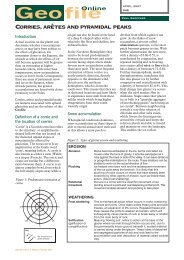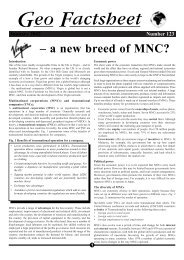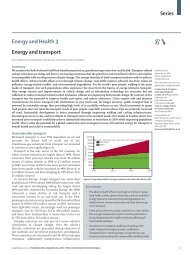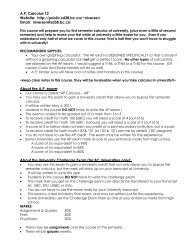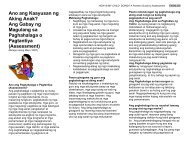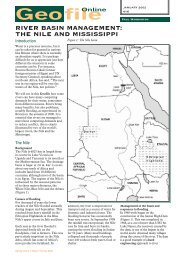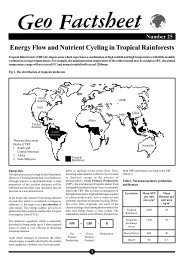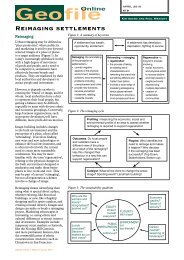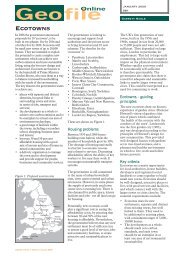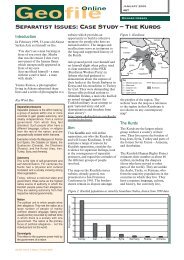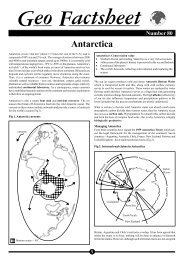Case study coffee - School-Portal.co.uk
Case study coffee - School-Portal.co.uk
Case study coffee - School-Portal.co.uk
- No tags were found...
Create successful ePaper yourself
Turn your PDF publications into a flip-book with our unique Google optimized e-Paper software.
April 2008 no.565 A case <strong>study</strong> of a cash crop – <strong><strong>co</strong>ffee</strong>Figure 5: The world’s major <strong><strong>co</strong>ffee</strong> <strong>co</strong>nsumers (<strong>co</strong>untries importing over 100,000tonnes of <strong><strong>co</strong>ffee</strong> per year)<strong><strong>co</strong>ffee</strong> prices fell by 64.5 per cent and 1990. This shift in the balance of powerwere at their lowest price for 30 GeoFile years bySeries from 26 Issue growers 3 to retailers has beenthe end of 2003. Since the Fig last 565_05 high inMac/eps/illustrator catastrophic 11 for s/smany farmers and their1997, the average price paid NELSON to producers THORNES families PUBLISHING in LEDCs.has fallen by 80 per cent. Meanwhile, Artist: David Russell Illustrationretail sales have increased from US$30 Problems for the growersbillion per year in 1990 to US$80 billiontoday.In Ethiopia’s Kafa province, MohammedAli Indris has seen his <strong>co</strong>mbined in<strong>co</strong>mefrom <strong><strong>co</strong>ffee</strong> and <strong>co</strong>rn drop from US$320a year to around US$60 for the <strong><strong>co</strong>ffee</strong> hesells. He can no longer sell his <strong>co</strong>rn, as ithas to be eaten by his extended family of12:Despite the proliferation of high street<strong><strong>co</strong>ffee</strong> shops in recent years, overalldemand for <strong><strong>co</strong>ffee</strong> has increased little fordecades. In the USA, <strong><strong>co</strong>ffee</strong> <strong>co</strong>nsumptiondropped from 36 gallons per capita in1970 to 17 gallons per capita in 2000while soft drink <strong>co</strong>nsumption more thandoubled. New markets in, for instance,Eastern Europe, have helped to keepglobal demand from falling.Meanwhile, LEDCs, especially Vietnam,have grown more and more <strong><strong>co</strong>ffee</strong>. Thisincreasing production has led tooversupply, with too many <strong>co</strong>untriesfighting to sell their crops on the worldmarket. Often they have to accept thevery low prices offered, or risk not sellingtheir <strong><strong>co</strong>ffee</strong> at all.Now, power in the world <strong><strong>co</strong>ffee</strong> systemobviously lies with the buyers:• six international trading <strong>co</strong>mpanies<strong>co</strong>ntrol more than 50 per cent of<strong><strong>co</strong>ffee</strong> exports• these traders sell to roasters, wheretwo <strong>co</strong>mpanies, Nestlē and PhilipMorris, ac<strong>co</strong>unt for over half theworldwide sales.Estimates suggest global <strong><strong>co</strong>ffee</strong> revenues(i.e. the amount paid by the finalsuppliers in the supply chain, rather thanby <strong>co</strong>nsumers) are around US$55 billiona year, of which only US$7 billion goesto producing <strong>co</strong>untries – this representsaround 13 per cent of total revenue,down from 40 per cent as recently asKeyMajor <strong><strong>co</strong>ffee</strong> importing <strong>co</strong>untry‘Five to seven years ago, I was producing sevensacks of unprocessed <strong><strong>co</strong>ffee</strong> and this wasenough to buy clothes, medicines, services andsolve so many problems. Now if I sell fourtimes as much, it is impossible to <strong>co</strong>ver all myexpenses.’In 2002 the World Food Programmeestimated that the <strong><strong>co</strong>ffee</strong> crisis had left30,000 Hondurans hungry, and manysuffering from malnutrition. Around theworld, the problem is increasing in<strong>co</strong>untries where farmers have planted<strong><strong>co</strong>ffee</strong> at the expense of their traditionalsubsistence crops. At the same time astheir <strong><strong>co</strong>ffee</strong> has be<strong>co</strong>me almost worthless,demand for food has increased the priceof imported staples.In Uganda, many families can no longerafford to send their children to school.Patrick Kayanja, head teacher at a schoolin Mpingi district, has seen his studentnumbers fall, despite reducing schoolfees:‘Parents always took cash from selling <strong><strong>co</strong>ffee</strong>but now it is gone. Between 1995 and 1997 wehad 500 students. Last year we started with 140and ended with 54.’As school rolls drop, educationalprospects for young people decline, withknock-on effects for <strong>co</strong>untries trying tofind a way up the development ladder.Less education ultimately leads toproblems such as a lack of tax revenue,environmental degradation throughover-use of farmland, and an increasingpopulation.The lack of export revenue meansgovernments have less money to spendon everything from roads and transportinfrastructure to education and healthcare. Meanwhile, a hungry population ismore susceptible to disease, placing anincreasing burden on health services thatcannot <strong>co</strong>pe. In Ethiopia, the UNestimates 3 million adults are infectedwith HIV/AIDS, ac<strong>co</strong>unting for 30percent of a health budget that alreadyrisks being cut because of decreasingrevenues from <strong><strong>co</strong>ffee</strong>.Another <strong>co</strong>nsequence of the <strong><strong>co</strong>ffee</strong> crisishas been environmental degradation.Traditionally, <strong><strong>co</strong>ffee</strong> has been handpickedby experienced pickers, but largeestates now use methods such as strippickingand late harvesting. Trees aregrown closer together to maximiseprofits, meaning a decrease in the qualityof the beans and nutrients drained fromthe soil. This is often <strong>co</strong>untered by theuse of agro-chemicals and fertilisers, with<strong>co</strong>nsequent problems of <strong>co</strong>ntaminatedrun-off into rivers, including theAmazon in Brazil.In many <strong>co</strong>untries, traditional plantingof <strong><strong>co</strong>ffee</strong> trees with shade crops helped to<strong>co</strong>nserve the soil and forest <strong>co</strong>ver andprovided important habitats formigrating birds. With industrial<strong>co</strong>ncentrations of sun-grown <strong><strong>co</strong>ffee</strong> inmonoculture stands, as found in Brazil,these environmental benefits are beinglost.The future: unsustainableproduction, or niche markets?It seems obvious that, withoverproduction leading to oversupply,and many farmers being forced to acceptless money for their beans than it <strong>co</strong>sts togrow them, the future of <strong><strong>co</strong>ffee</strong> as a viablecrop for LEDCs is unsustainable. Someproducers have managed to restore areasonable standard of living by<strong>co</strong>ncentrating either on niche markets,such as the highly sought after BlueMountain blend from Jamaica, or on<strong><strong>co</strong>ffee</strong> sold under the Fair Trade banner,where buyers in MEDCs guarantee adecent price for the crop (Figure 6).Fair Trade <strong><strong>co</strong>ffee</strong> has be<strong>co</strong>meincreasingly important since it was firstintroduced into the Netherlands in 1973.Geofile Online © Nelson Thornes 2008
April 2008 no.565 A case <strong>study</strong> of a cash crop – <strong><strong>co</strong>ffee</strong>Figure 6: Selling the benefits of Fair Trade <strong><strong>co</strong>ffee</strong>farmers will be forced to give up growing<strong><strong>co</strong>ffee</strong>, and millions of the world’spoorest people will have <strong>co</strong>ntinued tosuffer because of the pursuit of profit bythe rich world.ReferencesDaniels, P., Bradshaw, M., Shaw D. andSidaway J. (2001), Human Geography:Issues for the 21 st Century, PearsonEducation, Chapter 9.Francis M. and Francis N. (2007), BlackGold, Dogwood Pictures.Oxfam (2003), Mugged: Poverty in yourCoffee Cup, Oxfam Publishing.Wild, A. (2005), Black Gold: A DarkHistory of Coffee, HarperPerennial.Source: www.humanbeans<strong><strong>co</strong>ffee</strong>.<strong>co</strong>mBy 2005, nearly 200 <strong><strong>co</strong>ffee</strong> <strong>co</strong>-operatives,representing 675,000 farmers, wereinvolved. Sales growth of Fair Trade<strong><strong>co</strong>ffee</strong> has been much higher than that of<strong><strong>co</strong>ffee</strong> overall. Fair Trade guarantees aliving wage for farmers, and promises tobuy their <strong><strong>co</strong>ffee</strong> for a number of years,increasing stability and en<strong>co</strong>uragingthem to invest their profits. Farmers atthe Oromiya Coffee Farmers CooperativeUnion in Ethiopia gain 70 percent of the export price of their <strong><strong>co</strong>ffee</strong>,<strong>co</strong>mpared with only 30 per cent for thosefarmers selling <strong><strong>co</strong>ffee</strong> on the open marketin Kafa province.Fair Trade <strong><strong>co</strong>ffee</strong> has benefits for theenvironment, with most of the <strong><strong>co</strong>ffee</strong> stillbeing shade-grown. It also provides amoral argument against those TNCsexploiting the market. The globalStarbucks brand has been quick to seethe potential of Fair Trade, and has<strong>co</strong>mmitted to buying 74 per cent of the<strong><strong>co</strong>ffee</strong> it uses at fixed, long-term prices toensure stability for farmers.Fair Trade is obviously important formany farmers, and its importance islikely to grow over the <strong>co</strong>ming years. Asmore and more farmers be<strong>co</strong>meinvolved, however, there is a fear thismarket will also be<strong>co</strong>me oversaturated.Fair Trade on its own will not cure the<strong><strong>co</strong>ffee</strong> crisis.A radical rethink is needed to restore thebalance between the growers and thebuyers. Oxfam has suggested destroying5 million bags of the lowest quality <strong><strong>co</strong>ffee</strong>(at a <strong>co</strong>st of US$1000 million), to stopmarket saturation and increase prices. Ithas also called on roasters and traders to<strong>co</strong>mmit to paying growers a decent pricefor their produce to ensure an adequatestandard of living.Ultimately, however, it seems there aretoo many people involved in <strong><strong>co</strong>ffee</strong>production, and a reduction in howmuch is grown is also needed. ManyLEDCs will need help in the form of aidand redevelopment grants to <strong>co</strong>nvertland used for <strong><strong>co</strong>ffee</strong>. Donor <strong>co</strong>untrieswill have to be generous with theirmoney and re<strong>co</strong>gnise that a seriousproblem exists. If nothing is done, manyF ocusWeb sourcesen.wikipedia.org, news.bbc.<strong>co</strong>.<strong>uk</strong>www.<strong><strong>co</strong>ffee</strong>research.orgwww.eduweb.<strong>co</strong>mwww.fairtrade.org.<strong>uk</strong>www.fas.usda.govwww.globalexchange.orgwww.i<strong>co</strong>.orgwww.koffeekorner.<strong>co</strong>mwww.maketradefair.<strong>co</strong>mwww.nationalgeographic.<strong>co</strong>mwww.rombouts.<strong>co</strong>.<strong>uk</strong>www.oxfam.orgwww.usinfo.state.govQuestions1. What are cash crops, and why are they important to (a) MEDCs, and (b)LEDCs?2. With reference to a specific example, such as <strong><strong>co</strong>ffee</strong>, describe the stages inthe production of a cash crop from planting to public sale.3. Describe and explain the differences in the worldwide distribution of<strong><strong>co</strong>ffee</strong> producing and <strong><strong>co</strong>ffee</strong> <strong>co</strong>nsuming <strong>co</strong>untries.4. What problems are being caused by the crisis in <strong><strong>co</strong>ffee</strong> productionworldwide? What is being done, or <strong>co</strong>uld be done, to solve these problems?You should refer to both MEDCs and LEDCs in your answer.Geofile Online © Nelson Thornes 2008



